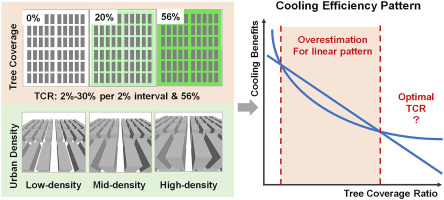当前位置:
X-MOL 学术
›
Build. Environ.
›
论文详情
Our official English website, www.x-mol.net, welcomes your
feedback! (Note: you will need to create a separate account there.)
The cooling efficiency of variable greenery coverage ratios in different urban densities: A study in a subtropical climate
Building and Environment ( IF 7.1 ) Pub Date : 2020-05-01 , DOI: 10.1016/j.buildenv.2020.106772 Wanlu Ouyang , Tobi Eniolu Morakinyo , Chao Ren , Edward Ng
Building and Environment ( IF 7.1 ) Pub Date : 2020-05-01 , DOI: 10.1016/j.buildenv.2020.106772 Wanlu Ouyang , Tobi Eniolu Morakinyo , Chao Ren , Edward Ng

|
Abstract Urban greenery, especially trees, has been proven to be one of the effective measures for urban heat island mitigation. However, no consistent findings have been found for the relationship between greenery abundance and cooling magnitude; while some previous studies discovered a linear relationship, others opined it could a non-linear one. In addition, there are rare studies exploring whether or not the strength of the relationship is dependent on urban density. Therefore, in this study, we aim to discuss cooling efficiency by measuring the relationship between greenery coverage ratio and the cooling effects of greenery. Parametric studies were conducted in a validated ENVI-met model, with different combinations of urban densities (Low, Mid, and High) and tree coverage ratios (2–30% at 2% interval, and 56% for full area coverage other than building). Then the pattern of the cooling efficiency was explored under three urban densities scenarios and two selected temporal periods on a typical summer daytime. For a subtropical climate background, results showed a non-linear (logarithmic) pattern for tree coverage ratio (TCR) and cooling effects, irrespective of the urban density, temporal periods, and heat indicators. When TCR reached 20–30%, the optimal cooling efficiency of trees were achieved, irrespective of building densities and temporal periods. The optimal threshold for greenery coverage in this study can provide science-based suggestions to urban planners and designers for better microclimate and thermal comfort environments at the neighborhood scale.
中文翻译:

不同城市密度下不同绿化覆盖率的降温效率:亚热带气候研究
摘要 城市绿化,尤其是树木,已被证明是缓解城市热岛的有效措施之一。然而,对于绿化丰度与降温幅度之间的关系,尚未发现一致的发现;虽然之前的一些研究发现了线性关系,但其他人认为它可能是非线性关系。此外,很少有研究探讨这种关系的强度是否取决于城市密度。因此,在本研究中,我们旨在通过测量绿化覆盖率与绿化降温效果之间的关系来讨论降温效率。参数研究是在经过验证的 ENVI-met 模型中进行的,具有不同的城市密度组合(低、中和高)和树木覆盖率(2-30%,间隔 2%,56% 的全区域覆盖(建筑物除外))。然后在典型的夏季白天在三个城市密度情景和两个选定的时间段下探索了冷却效率的模式。对于亚热带气候背景,结果显示树木覆盖率 (TCR) 和降温效果呈非线性(对数)模式,而与城市密度、时间段和热度指标无关。当 TCR 达到 20-30% 时,无论建筑密度和时间段如何,都可以实现树木的最佳冷却效率。本研究中绿化覆盖的最佳阈值可以为城市规划者和设计师提供基于科学的建议,以在邻里范围内改善小气候和热舒适环境。然后在典型的夏季白天在三个城市密度情景和两个选定的时间段下探索了冷却效率的模式。对于亚热带气候背景,结果显示树木覆盖率 (TCR) 和降温效果呈非线性(对数)模式,而与城市密度、时间段和热度指标无关。当 TCR 达到 20-30% 时,无论建筑密度和时间段如何,都可以实现树木的最佳冷却效率。本研究中绿化覆盖的最佳阈值可以为城市规划者和设计师提供基于科学的建议,以在邻里范围内改善小气候和热舒适环境。然后在典型的夏季白天在三个城市密度情景和两个选定的时间段下探索了冷却效率的模式。对于亚热带气候背景,结果显示树木覆盖率 (TCR) 和降温效果呈非线性(对数)模式,而与城市密度、时间段和热度指标无关。当 TCR 达到 20-30% 时,无论建筑密度和时间段如何,都可以实现树木的最佳冷却效率。本研究中绿化覆盖的最佳阈值可以为城市规划者和设计师提供基于科学的建议,以在邻里范围内改善小气候和热舒适环境。结果表明,无论城市密度、时间段和热度指标如何,树木覆盖率 (TCR) 和冷却效果都呈非线性(对数)模式。当 TCR 达到 20-30% 时,无论建筑密度和时间段如何,都可以实现树木的最佳冷却效率。本研究中绿化覆盖的最佳阈值可以为城市规划者和设计师提供基于科学的建议,以在邻里范围内改善小气候和热舒适环境。结果表明,无论城市密度、时间段和热度指标如何,树木覆盖率 (TCR) 和冷却效果都呈非线性(对数)模式。当 TCR 达到 20-30% 时,无论建筑密度和时间段如何,都可以实现树木的最佳冷却效率。本研究中绿化覆盖的最佳阈值可以为城市规划者和设计师提供基于科学的建议,以在邻里范围内改善小气候和热舒适环境。
更新日期:2020-05-01
中文翻译:

不同城市密度下不同绿化覆盖率的降温效率:亚热带气候研究
摘要 城市绿化,尤其是树木,已被证明是缓解城市热岛的有效措施之一。然而,对于绿化丰度与降温幅度之间的关系,尚未发现一致的发现;虽然之前的一些研究发现了线性关系,但其他人认为它可能是非线性关系。此外,很少有研究探讨这种关系的强度是否取决于城市密度。因此,在本研究中,我们旨在通过测量绿化覆盖率与绿化降温效果之间的关系来讨论降温效率。参数研究是在经过验证的 ENVI-met 模型中进行的,具有不同的城市密度组合(低、中和高)和树木覆盖率(2-30%,间隔 2%,56% 的全区域覆盖(建筑物除外))。然后在典型的夏季白天在三个城市密度情景和两个选定的时间段下探索了冷却效率的模式。对于亚热带气候背景,结果显示树木覆盖率 (TCR) 和降温效果呈非线性(对数)模式,而与城市密度、时间段和热度指标无关。当 TCR 达到 20-30% 时,无论建筑密度和时间段如何,都可以实现树木的最佳冷却效率。本研究中绿化覆盖的最佳阈值可以为城市规划者和设计师提供基于科学的建议,以在邻里范围内改善小气候和热舒适环境。然后在典型的夏季白天在三个城市密度情景和两个选定的时间段下探索了冷却效率的模式。对于亚热带气候背景,结果显示树木覆盖率 (TCR) 和降温效果呈非线性(对数)模式,而与城市密度、时间段和热度指标无关。当 TCR 达到 20-30% 时,无论建筑密度和时间段如何,都可以实现树木的最佳冷却效率。本研究中绿化覆盖的最佳阈值可以为城市规划者和设计师提供基于科学的建议,以在邻里范围内改善小气候和热舒适环境。然后在典型的夏季白天在三个城市密度情景和两个选定的时间段下探索了冷却效率的模式。对于亚热带气候背景,结果显示树木覆盖率 (TCR) 和降温效果呈非线性(对数)模式,而与城市密度、时间段和热度指标无关。当 TCR 达到 20-30% 时,无论建筑密度和时间段如何,都可以实现树木的最佳冷却效率。本研究中绿化覆盖的最佳阈值可以为城市规划者和设计师提供基于科学的建议,以在邻里范围内改善小气候和热舒适环境。结果表明,无论城市密度、时间段和热度指标如何,树木覆盖率 (TCR) 和冷却效果都呈非线性(对数)模式。当 TCR 达到 20-30% 时,无论建筑密度和时间段如何,都可以实现树木的最佳冷却效率。本研究中绿化覆盖的最佳阈值可以为城市规划者和设计师提供基于科学的建议,以在邻里范围内改善小气候和热舒适环境。结果表明,无论城市密度、时间段和热度指标如何,树木覆盖率 (TCR) 和冷却效果都呈非线性(对数)模式。当 TCR 达到 20-30% 时,无论建筑密度和时间段如何,都可以实现树木的最佳冷却效率。本研究中绿化覆盖的最佳阈值可以为城市规划者和设计师提供基于科学的建议,以在邻里范围内改善小气候和热舒适环境。










































 京公网安备 11010802027423号
京公网安备 11010802027423号